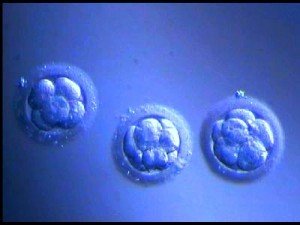 New research describes a breakthrough in IVF technology that proponents claim will significantly increase live birth rates in fertility clinics.
New research describes a breakthrough in IVF technology that proponents claim will significantly increase live birth rates in fertility clinics.
The technique uses precision time-lapse imaging to more accurately distinguish developing embryos with normal and abnormal numbers of chromosomes.
The study found that embryos with too many or too few chromosomes typically reach specific growth milestones several hours later than those with 23 (the usual number). Researchers then applied these findings to screen embryos ahead of implantation, identifying those with a higher likelihood of successful continued development.
The news is based on a study published in the journal Reproductive BioMedicine Online.
(A second related study can be found here)
Our colleagues at the UK SMC have rounded up the following expert comments on the research.
Sue Avery, Director of Birmingham Women’s Fertility Centre, said:
“This is an interesting piece of science which has successfully identified a factor that is associated with improved implantation. Unfortunately the study does not compare this exciting new approach with standard practise in embryology in which embryologists already look for the best embryos to place in the womb. Until the new technique is compared to current practise we cannot know whether different embryos are being chosen. The IVF community needs a prospective randomised controlled trial to prove that the new approach delivers better results before it can be recommended to patients. Until then this study is an interesting piece of science but not clinically significant.”
Mr Stuart Lavery MRCOG, Consultant Gynaecologist and Director IVF at Hammersmith Hospital, said:
“Time lapse imaging of the early development of human embryos offers the exciting potential of a novel and non-invasive way of selecting the embryo with the greatest chance of implantation. The authors suggest that using a retrospective analysis against a predictive model of chromosomal abnormality, this new approach could provide accurate and reliable information to allow selection without the need for invasive biopsy and expensive chromosomal analysis. To confirm this a prospective randomised trial using time lapse imaging in comparison with standard embryology selection techniques as well as chromosomal screening would be necessary. Several IVF units around the country have already adopted time lapse photography into their clinical service, this research adds to the evolving evidence base supporting its use.”
Dr Allan Pacey, Senior Lecturer in Andrology, University of Sheffield, and Chair of the British Fertility Society, said:
“This paper is interesting because we really do need to make advances in selecting the best embryos created during IVF. The idea of monitoring embryo development more closely is being used increasing in clinics around the world and so it is good to see the science involved submitted to peer review and publication. All too often developments in IVF are trumpeted as advances when they remain unproven. In this case, whilst this is a good piece of science, before we splash this on the front page it should be subject to full randomised control trials.”
Sheena Lewis, Professor of Reproductive Medicine, Queen’s University Belfast, said:
“This may well be the technique we have been waiting for to improve embryo selection and thus success in fertility treatment. It is certainly timely to develop new ways of looking at embryo health since we have been basing embryo choice on just cell number and shape since IVF began. Time lapse imaging provides the opportunity to give continuous, detailed information on how the embryo is growing. However, this is a small study with just 46 embryos being followed through to birth. Much more research will be needed before this becomes a routine clinical tool. “